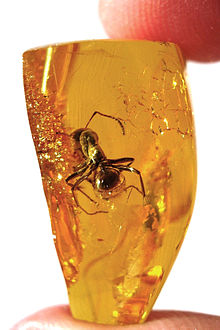Amber – a study in science
 What was life like on planet earth 50 million years ago? That’s a good question, one that scientists, historians, archeologists and researchers are always looking for answers to. Perhaps the most fascinating and incredible discoveries of that period in time came with the finding of inclusions – tiny bits of insects and plant life – encapsulated in Baltic Amber. Imagine almost microscopic bugs trapped in a sticky solution that traveled in moving water, and then being solidified inside the substance as it hardened. If the whole scenario were captured on video, it would be the starring attraction on YouTube.
What was life like on planet earth 50 million years ago? That’s a good question, one that scientists, historians, archeologists and researchers are always looking for answers to. Perhaps the most fascinating and incredible discoveries of that period in time came with the finding of inclusions – tiny bits of insects and plant life – encapsulated in Baltic Amber. Imagine almost microscopic bugs trapped in a sticky solution that traveled in moving water, and then being solidified inside the substance as it hardened. If the whole scenario were captured on video, it would be the starring attraction on YouTube.
It was definitely the time travel story that rocked the world of science when, for the very first time, they were able to see what insects looked like 50 million years ago. And much like a series of video clips, actually see the insects in various stages of their existence – mating, shedding cocoons, even laying their eggs. Even then, there was the occasional swarm of mosquitos patterned in still life in the resin. In fact, a strong percentage of those same insects remain unchanged today. Including those pesky mosquitos!
What other amazing discoveries came from the study of Amber inclusions? First, let us consider the fact that on examination, the inclusions were totally visible from the outside of the sphere of amber. So it was startling and obviously disappointing when scientists attempted to remove a section from the Amber fossil that contained a beautifully preserved inclusion: the inclusion was destroyed because these trapped organisms are decomposed. While they remain intact – preserved – within the amber fossil, even the tiniest details – hair and scale – would be very evident. But removed from their protective “cave,” they cannot survive.
Despite the occasional set back, the exceptional findings of almost 3,500 fossil fauna found in amber was a scientist’s dream come true. To be able to identify that between 10% and 15% actually still exist today – and very similar to their ancestors, was an enormous step in tracing the history of human organisms.
But there’s more to the amber story. In addition to the insect life of ancient times, scientists also found tiny fragments of plants including flowers or petals, little leaves, needles, and small twigs and fruits. These findings are definitely rarer. From specific research, we know that ferns, moss, fungi and lichen existed at that time and that red chestnut, willow, maple trees also grew alongside magnolia, palm and even cinnamon trees. From the very cold forest in which conifers flourished to the subsequent centuries blushed with warmer climate, life forms migrated and some changed form.
When you think about it, is it so surprising that a dinosaur’s tail could measure 85 feet in length? Not really. Because when you think about it, we’re really at the tip of the iceberg in discovering life on our planet earth.
Sincerely
Svajunas Petreikis
E-mail svajunas@amberartisan.com